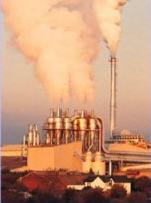
Back نموذج انتشار جوي Arabic Modelování rozptylu znečišťujících látek v ovzduší Czech Ausbreitungsrechnung German Õhusaaste leviku modelleerimine Estonian مدلسازی انتشار آلایندههای هوا Persian Modélisation de la dispersion atmosphérique French Modelli di dispersione in atmosfera Italian 大気拡散 Japanese 대기 확산 모델링 Korean Modelowanie dyspersji odorantów Polish

| Part of a series on |
| Pollution |
|---|
 |
Atmospheric dispersion modeling is the mathematical simulation of how air pollutants disperse in the ambient atmosphere. It is performed with computer programs that include algorithms to solve the mathematical equations that govern the pollutant dispersion. The dispersion models are used to estimate the downwind ambient concentration of air pollutants or toxins emitted from sources such as industrial plants, vehicular traffic or accidental chemical releases. They can also be used to predict future concentrations under specific scenarios (i.e. changes in emission sources). Therefore, they are the dominant type of model used in air quality policy making. They are most useful for pollutants that are dispersed over large distances and that may react in the atmosphere. For pollutants that have a very high spatio-temporal variability (i.e. have very steep distance to source decay such as black carbon) and for epidemiological studies statistical land-use regression models are also used.
Dispersion models are important to governmental agencies tasked with protecting and managing the ambient air quality. The models are typically employed to determine whether existing or proposed new industrial facilities are or will be in compliance with the National Ambient Air Quality Standards (NAAQS) in the United States and other nations. The models also serve to assist in the design of effective control strategies to reduce emissions of harmful air pollutants. During the late 1960s, the Air Pollution Control Office of the U.S. EPA initiated research projects that would lead to the development of models for the use by urban and transportation planners.[1] A major and significant application of a roadway dispersion model that resulted from such research was applied to the Spadina Expressway of Canada in 1971.
Air dispersion models are also used by public safety responders and emergency management personnel for emergency planning of accidental chemical releases. Models are used to determine the consequences of accidental releases of hazardous or toxic materials, Accidental releases may result in fires, spills or explosions that involve hazardous materials, such as chemicals or radionuclides. The results of dispersion modeling, using worst case accidental release source terms and meteorological conditions, can provide an estimate of location impacted areas, ambient concentrations, and be used to determine protective actions appropriate in the event a release occurs. Appropriate protective actions may include evacuation or shelter in place for persons in the downwind direction. At industrial facilities, this type of consequence assessment or emergency planning is required under the U.S. Clean Air Act (CAA) codified in Part 68 of Title 40 of the Code of Federal Regulations.
The dispersion models vary depending on the mathematics used to develop the model, but all require the input of data that may include:
- Meteorological conditions such as wind speed and direction, the amount of atmospheric turbulence (as characterized by what is called the "stability class"), the ambient air temperature, the height to the bottom of any inversion aloft that may be present, cloud cover and solar radiation.
- Source term (the concentration or quantity of toxins in emission or accidental release source terms) and temperature of the material
- Emissions or release parameters such as source location and height, type of source (i.e., fire, pool or vent stack) and exit velocity, exit temperature and mass flow rate or release rate.
- Terrain elevations at the source location and at the receptor location(s), such as nearby homes, schools, businesses and hospitals.
- The location, height and width of any obstructions (such as buildings or other structures) in the path of the emitted gaseous plume, surface roughness or the use of a more generic parameter "rural" or "city" terrain.
Many of the modern, advanced dispersion modeling programs include a pre-processor module for the input of meteorological and other data, and many also include a post-processor module for graphing the output data and/or plotting the area impacted by the air pollutants on maps. The plots of areas impacted may also include isopleths showing areas of minimal to high concentrations that define areas of the highest health risk. The isopleths plots are useful in determining protective actions for the public and responders.
The atmospheric dispersion models are also known as atmospheric diffusion models, air dispersion models, air quality models, and air pollution dispersion models.
- ^ Fensterstock, J.C. et al., "Reduction of air pollution potential through environmental planning", JAPCA, Vol.21, No.7, 1971.